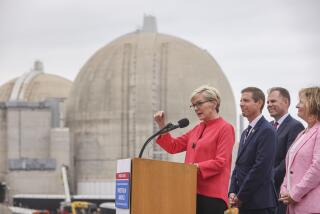Plutonium-Disposal Plans Trigger Environmentalists’ Ire
- Share via
WASHINGTON — Energy Department plans to destroy 50 tons of surplus Cold War plutonium by encasing it in glass or burning it in nuclear reactors drew sharp reaction Monday from critics who fear that the solution is a sop to the nuclear power industry.
Energy officials argued that the plan represents the most prudent way to dispose of plutonium. But they acknowledged that important issues involving the cost, environmental safety and technology remain unanswered.
The Energy Department plan does not indicate where the plutonium will be burned or, if encased in glass, where it will be buried. At best, the process would take 20 to 30 years to complete--and would result in waste products that remain radioactive for thousands of years.
Plutonium, created during World War II, is a component of nuclear bombs that is used to start an atomic fission reaction which triggers the powerful fusion blast. Plutonium also can be converted to a fuel and burned in some nuclear reactors to produce energy.
The plan to burn or encase plutonium in glass is certain to lead to extended lawsuits, fights over environmental impact statements and disputes over nuclear licensing, as well as the enactment of new laws by Congress.
The battle began even as Energy Secretary Hazel O’Leary outlined her decision Monday. In the Energy Department auditorium, where O’Leary spoke, environmental groups and a nuclear power industry group began handing out competing leaflets.
Environmental groups said that burning the plutonium--even to destroy it--would send an international signal that the United States has endorsed the commercial use of plutonium. Japan, France and Russia, among others, want to burn plutonium in commercial reactors, and Russia continues to produce and separate plutonium.
“The most influential and wealthy supporters of this plan [are] the . . . companies that design and make nuclear reactors,” said Daryl Kimball, director of nuclear programs at Physicians for Social Responsibility.
But O’Leary said that the U.S. proposal to burn plutonium is completely opposite Russia’s ongoing production of plutonium.
“Whether we burn it or put it in glass, the bottom line is the same,” O’Leary said. “For the first time in history we will be destroying, instead of creating, weapons-grade plutonium.”
During the Cold War, nuclear weapons plants created about 100 tons of plutonium, about half of which has been declared surplus by the Clinton administration. Russia has about 200 tons of plutonium.
O’Leary said that Energy Department experts in Washington provided the technical evaluations for the plan, including an estimate that set the cost at about $2.2 billion.
But Energy Department officials acknowledged that the cost estimate is highly uncertain. For example, they do not know whether they will have to pay incentive fees to utilities to take the plutonium fuel. Utilities will have to modify nuclear reactors and amend their operating licenses to burn the plutonium.
“Most utilities wouldn’t touch this stuff for the world,” said Thomas Cochran, a nuclear expert at the Natural Resources Defense Council.
Cochran said that the $2.2 billion figure is most likely too low. Indeed, Energy Department projects traditionally have had large cost overruns, particularly in the area of nuclear cleanup.
Under the plan, the Energy Department would consolidate the storage of plutonium from seven sites to three and would attempt to build a plant to encase plutonium in glass or ceramic in either South Carolina or Washington.
The government also would build a mixed-oxide fuel plant in either Texas, Idaho, Washington or South Carolina to convert plutonium into a burnable fuel.
The United States is considering disposing of plutonium with two technologies because about one-third of the surplus amount is in the form of mixed waste, which may be difficult or even impossible to purify for use as a reactor fuel.
The formal decision will be subject to a 30-day public comment period before a final decision is announced.
The administration attempted to put up a united front in support of the plan Monday. “I can tell you that President Clinton has personally approved of this approach and the White House stands firmly behind it,” said White House science advisor John Gibbons.
Nonetheless, the plan was crafted without the advice of Los Alamos National Laboratory, the nation’s central repository of information about plutonium. “We have been little involved and little consulted in these policy issues,” said Sid Hecker, Los Angeles director.
More to Read
Sign up for Essential California
The most important California stories and recommendations in your inbox every morning.
You may occasionally receive promotional content from the Los Angeles Times.














